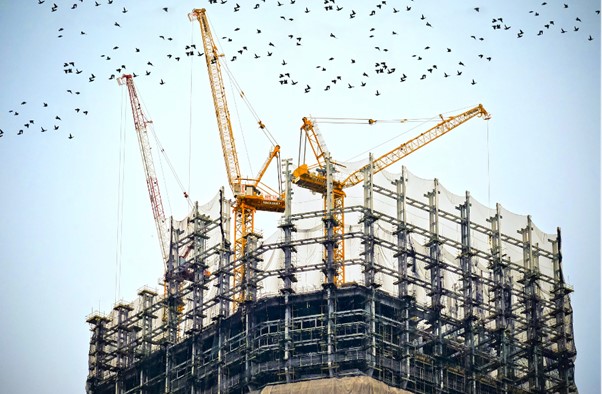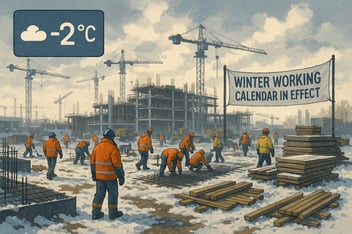Working in construction can be dangerous, especially when there is wind. In fact, the wind is often cited as one of the most destructive natural disasters. High wind speeds can cause scaffolding to collapse, cranes to topple over, and workers to be blown off roofs.
The Tacoma Narrows Bridge collapse that happened in the 1940s is a case in point. More recently, the Occupation Health and Safety Administration (OSHA) in the US has blamed wind as the cause or contributing factor of several high-profile construction accidents, such as the failures of three hammerhead cranes on September 10, 2017, in Miami and Fort Lauderdale in the Wake of Hurricane Irma and the 2016 crane collapse at 40 Worth Street, New York.
Knowing the wind speed limits for various construction tasks and considering wind conditions when planning your workday is critical.
Below, we answer some commonly asked questions about high wind safety in construction.
What Is Wind Gust vs. Wind Speed?
A gust is a sudden burst of wind that is often stronger and briefer than the average wind speed. Wind speed is measured by wind meters or anemometers, and wind gusts can be up to 40% stronger than the wind speed at any given time. The unit for sustained wind speed depends on the traditions of a particular country. For example, in the UK, wind speed is measured in miles per hour, while in the US, it's measured in knots.
What Are Wind Speed Limits for Crane Lifts?
Wind speed limits for crane lifts are put in place for various reasons. The most obvious reason is to ensure the safety of the crane operators and passers-by, as the wind can cause the crane to tip over. Additionally, wind can damage the crane itself, and high winds can make it difficult or impossible to control the crane.
As a result, wind speed limits for crane lifts are typically set at 20 mph (8.9 metres per second) or below. However, some cranes may be able to operate at wind speeds up to 39 mph (17.4 metres per second), though capacity reductions may apply. All crane operations must cease when wind speeds exceed 40 mph (17.9 metres per second).
What Wind Speed Is Too Windy for Scaffolding and Swing Stages?
When it comes to scaffolding and swing stages, how windy is too windy? Maximum wind speed for scaffolding is 25 mph (40 kph) for two-point systems and 20 mph (32 kmph) for single-point systems. Of course, these are just maximum speeds – if the wind is blowing at or near these speeds, it's probably best to stop work.
This is because high winds can make scaffolding and swing stages unstable, increasing the risk of accidents. In addition, high winds can make it difficult or impossible to work safely. So, if you're wondering whether it's too windy to be working on scaffolding or a swing stage, err on the side of extreme caution and call it a day if the wind is blowing too hard.
What Wind Speed Is Too Windy to Use a Boom Lift?
Given that a boom lift is a type of aerial lift, it's no surprise that wind speed is a key safety consideration when using one. After all, strong winds can pose a serious risk of tipping over the lift and injuring the workers on board. So what wind speed is too windy to use a boom lift or operate hoisting equipment? While it depends on the manufacturer's specifications, most boom lifts should not be used in winds exceeding 20 mph.
The Beaufort Wind Force Scale also recommends that most boom lifts should only be used when wind speed scores less than level 5 on its scale of 0 to 12. Taking this precaution can help ensure that your boom lift remains stable and secure, even in gusty conditions.

OSHA Wind Speed for Roofing
OSHA does not explicitly define what wind speed is too high for roofing work. OSHA only mentions "high winds" in the regulations. In the UK, The National Federation of Roofing Contractors recommends that roofing work should cease at wind speeds of 23 mph (10.3 metres per second). This is due to the fact that high winds can pose a danger to both workers and the general public.
High Wind Safety Construction: Working Safely in High Winds
Construction safety is always a top priority, but it's especially important when working in high winds. Before starting any work, check the weather reports and only proceed if conditions are safe. Weather reports should be closely monitored in order to anticipate when conditions may become hazardous.
Once you're on-site, take extra care to secure any partially built structures or scaffolding. This will help to prevent them from being toppled by strong gusts of wind. Always wear eye protection to guard against flying debris and keep an anemometer on hand to measure wind speed. By taking these precautions, you can help ensure that your construction site is safe for workers and pedestrians.
If you are looking for further resources about how you can protect yourself from accidents related to high winds, then please check out the Construction Safety Campaign: Common Accidents and Toolbox Safety Tips from Shulman and Hill. This thorough piece of work highlights a range of issues that could occur in a construction setting.
Leverage EHAB’s Weather Risk Platform for Construction
Managing wind safety on construction sites can be challenging, but tools are available to help. The EHAB Weather Risk Platform for Construction offers hyper-local climate-adjusted datasets, machine learning, and modern construction planning features to minimise weather risk and deliver significant cost savings. In addition, this tool allows construction sites to make informed decisions about wind safety, leading to a safer work environment.
For more information on how this tool can benefit your construction business, sign up to the platform for free: at the top of https://ehab.co/



